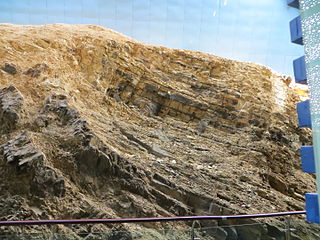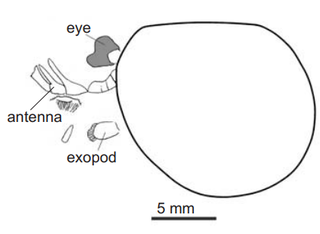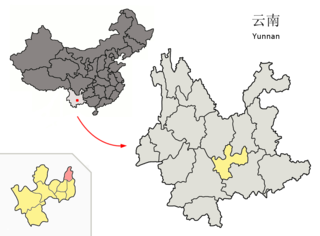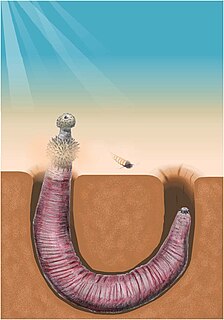
The Maotianshan Shales are a series of Early Cambrian deposits in the Chiungchussu Formation, famous for their Konservat Lagerstätten, deposits known for the exceptional preservation of fossilized organisms or traces. The Maotianshan Shales form one of some forty Cambrian fossil locations worldwide exhibiting exquisite preservation of rarely preserved, non-mineralized soft tissue, comparable to the fossils of the Burgess Shale. They take their name from Maotianshan Hill in Chengjiang County, Yunnan Province, China.

Forfexicaris valida is a species of Lower Cambrian arthropod, the only species in the family Forfexicarididae. It is known from only two specimens from the Maotianshan shale Lagerstätte.

Parapeytoia was a prehistoric animal that lived over 530 million years ago in the Maotianshan shales of prehistoric China. It was interpreted as an anomalocaridid (radiodont) with legs, but later studies reveal it was a megacheiran, a group of arthropods which are no longer thought to be closely related to the radiodonts.

Acanthomeridion is an extinct arthropod found in the Chengjiang fauna deposits of China. In 1997, it was placed in its own, monotypic family, Acanthomeridiidae. It is known from eight specimens, all found in China.

Chengjiang is a city located in Yuxi, Yunnan Province, China, just north of Fuxian Lake.

Chuandianella ovata is an extinct shrimp-like arthropod with unknown affinity that lived during the Atdabanian Age of the Early Cambrian. It is the only species classified under the genus Chuandianella. Its fossils were recovered from the Chengjiang Lagerstätte of the Maotianshan Shales in China. Its carapace was made up of calcium phosphate.

Haikoucaris is a genus of megacheiran arthropod that contains the single species Haikoucaris ercaiensis. It was discovered in the Cambrian Chengjiang biota of China.
Kunmingella is genus of Cambrian bradoriid from the Chengjiang biota, containing the single species K. douvillei.
Kunyangella is genus of Cambrian arthropod known for being a member of the Chengjiang biota, containing the single species K. cheni. It has a bivalved carapace and has tentatively been referred to the Bradoriida.

Archaeopriapulida is a group of priapulid-like worms known from Cambrian lagerstätte. The group is closely related to, and very similar to, the modern Priapulids. It is unclear whether it is mono- or polyphyletic. Despite a remarkable morphological similarity to their modern cousins, they fall outside of the priapulid crown group, which is not unambiguously represented in the fossil record until the Carboniferous. They are probably closely related or paraphyletic to the palaeoscolecids; the relationship between these basal worms is somewhat unresolved.

The palaeoscolecids are a group of extinct ecdysozoan worms resembling armoured priapulids. They are known from the Lower Cambrian to the late Silurian; they are mainly found as disarticulated sclerites, but are also preserved in many of the Cambrian lagerstätten. They take their name from the typifying genus Palaeoscolex. Other genera include Cricocosmia from the Lower Cambrian Chengjiang biota.

Selkirkia is a genus of predatory, tubicolous priapulid worms known from the Middle Cambrian Burgess Shale, Ogygopsis Shale and Puncoviscana Formation. 142 specimens of Selkirkia are known from the Greater Phyllopod bed, where they comprise 0.27% of the community. In the Burgess Shale, 20% of the tapering, organic-walled tubes are preserved with the worm inside them, whereas the other 80% are empty. Whilst alive, the tubes were probably vertical, whereas trilobite-occupied tubes are horizontal.
Archotuba is a genus of elongated conical tubes that were seemingly deposited by colonial organisms. Known from the Chengjiang, its biological affinity is uncertain; it somewhat resembles the tubes of the 'priapulid' Selkirkia, but a cnidarian affinity is also possible. In the absence of soft parts, there really isn't enough data to confirm a biological affiliation.
Acosmia is a genus of Chengjiang biota priapulid in the family Acosmiidae. It is represented by a single rare species, Acosmiamaotiania.

Sicyophorus is a genus of archaeopriapulid known from the Chengjiang biota; synonymous with Protopriapulites haikouensis.

Eximipriapulus is a genus of priapulid-like organisms, perhaps belonging to the crown group, known from the Chengjiang biota.
Corynetis is a genus of archaeopriapulid known from the Chengjiang biota, and a senior synonym of Anningvermis multispinosus.
Nidelric is a Cambrian genus of scleritomous organism, tentatively interpreted as a chancelloriid.
Prototreta flabellata is one of several species of brachiopod that occur in the Cambrian rocks of central and southern Montana, Nixon Gulch section, Three Forks Quad. It is associated with the trilobite genus Ehmania near the base of the Middle Cambrian Meagher limestone.

Luohuilinella is an extinct genus of xandarellid artiopodan arthropod known from the Chengjiang biota of China. The type species Luohuilinella rarus was described in 2012. A second species Luohuilinella deletres was described in 2018. Both taxa are rare components of the assemblage. Like other Xandarellids and most artiopodans, it possessed an unmineralised exoskeleton. The type and currently only known specimen of L. rarus is known from a dorsal exoskeleton, around 17 mm long and 9 mm wide which consists of 27 tergites with pronounced pleural spines. L. deletres is much larger, with specimens being over 10 cm long, L. deletres possessed at least 11 pairs of biramous appendages. Both taxa are dorsoventrally flattened, making a benthic or nektobenthic lifestyle probable. Both taxa have pronounced notches in the cephalon to accommodate the stalked eyes.













